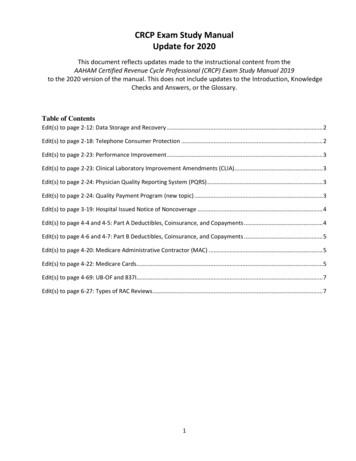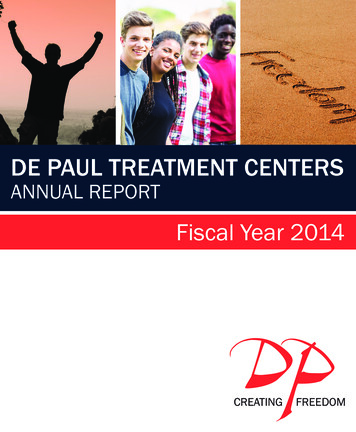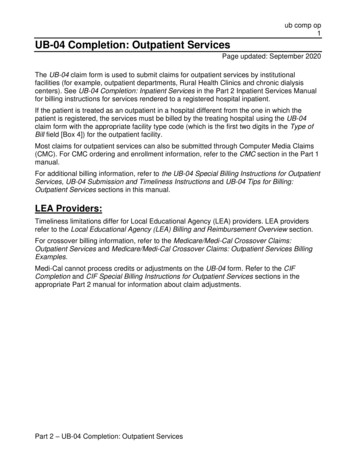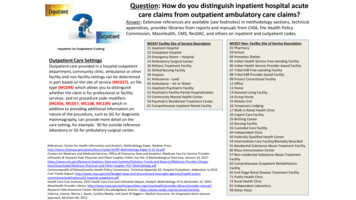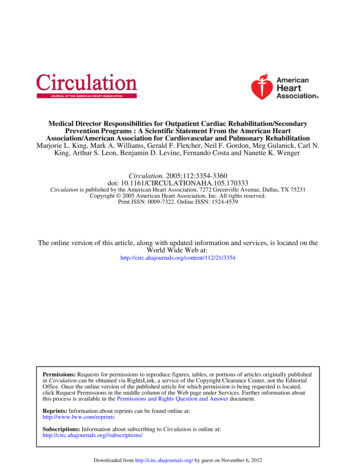
Transcription
Medical Director Responsibilities for Outpatient Cardiac Rehabilitation/SecondaryPrevention Programs : A Scientific Statement From the American HeartAssociation/American Association for Cardiovascular and Pulmonary RehabilitationMarjorie L. King, Mark A. Williams, Gerald F. Fletcher, Neil F. Gordon, Meg Gulanick, Carl N.King, Arthur S. Leon, Benjamin D. Levine, Fernando Costa and Nanette K. WengerCirculation. 2005;112:3354-3360doi: 10.1161/CIRCULATIONAHA.105.170333Circulation is published by the American Heart Association, 7272 Greenville Avenue, Dallas, TX 75231Copyright 2005 American Heart Association, Inc. All rights reserved.Print ISSN: 0009-7322. Online ISSN: 1524-4539The online version of this article, along with updated information and services, is located on theWorld Wide Web Permissions: Requests for permissions to reproduce figures, tables, or portions of articles originally publishedin Circulation can be obtained via RightsLink, a service of the Copyright Clearance Center, not the EditorialOffice. Once the online version of the published article for which permission is being requested is located,click Request Permissions in the middle column of the Web page under Services. Further information aboutthis process is available in the Permissions and Rights Question and Answer document.Reprints: Information about reprints can be found online at:http://www.lww.com/reprintsSubscriptions: Information about subscribing to Circulation is online loaded from http://circ.ahajournals.org/ by guest on November 6, 2012
AHA/AACVPR Scientific StatementMedical Director Responsibilities for Outpatient CardiacRehabilitation/Secondary Prevention ProgramsA Scientific Statement From the American Heart Association/AmericanAssociation for Cardiovascular and Pulmonary RehabilitationMarjorie L. King, MD, Co-Chair; Mark A. Williams, PhD, Co-Chair; Gerald F. Fletcher, MD;Neil F. Gordon, MD, PhD; Meg Gulanick, PhD, RN; Carl N. King, EdD; Arthur S. Leon, MD;Benjamin D. Levine, MD; Fernando Costa, MD; Nanette K. Wenger, MDOutpatient cardiac rehabilitation/secondary preventionprograms are characterized by comprehensive services,including medical evaluation, prescribed exercise, and cardiovascular disease risk factor modification throughevidence-based pharmacological management of risk factorsand behavioral interventions. This multifactorial process isdesigned to limit the adverse physiological and psychologicaleffects of cardiac illness, to reduce the risk of sudden death orreinfarction, to control cardiac symptoms, to stabilize orreverse the atherosclerotic process, and to enhance the patient’s psychosocial and vocational status.1 Provision of theseservices is physician directed and implemented by a team ofhealthcare professionals that may include nurses, exercisephysiologists, dietitians, health educators, behavioral medicine specialists, and other healthcare professionals.2Appropriate patient/physician interaction during cardiacrehabilitation is important from a clinical and a regulatoryperspective. In practice, the cardiac rehabilitation team interacts with a patient multiple times per week, providing anopportunity to facilitate management of blood pressure andlipids, glycemic control, smoking cessation, medication compliance, and adherence to lifestyle modification. Althoughlong-term management of these issues is the responsibility ofthe primary care physician and/or cardiologist, cardiac rehabilitation provides an opportunity for concentrated risk factormodification during a critical period for the patient withcoronary heart disease. By working closely with referringphysicians, the cardiac rehabilitation team can assist thepatient in reaching target goals more efficiently. The medicaldirector is ultimately responsible for ensuring that systemsare in place to facilitate this process and that appropriatecommunication with referring physicians is maintained.This document will serve as a guide for the medicaldirector of an outpatient cardiac rehabilitation/secondaryprevention program to link the clinical aspects of physicianinvolvement to the provision of services by program staffwhile maintaining compliance with regulatory requirements.It is not meant to replicate the excellent reviews, practicalguidelines, and scientific statements published elsewhere3–7that describe the rationale for and detailed structure ofcomprehensive cardiac rehabilitation programs. Rather, itprovides an overview of specific responsibilities for themedical director of an outpatient cardiac rehabilitation andsecondary prevention program. Patient participation in thisprogramming is frequently the first step in developing alifelong commitment to the secondary prevention of coronaryheart disease.Medical Director as Team LeaderThe primary role of the medical director, as leader of themultidisciplinary team, is to ensure that the cardiac rehabilitation/secondary prevention program is safe, comprehensive,cost-effective, and medically appropriate for individual patients. The medical director should have expertise in cardiovascular disease management and secondary prevention,training and experience with exercise training of patients withheart disease, and interpersonal skills related to leading andparticipating in a multidisciplinary team.The medical director’s responsibilities relate primarily tooversight of program policies and procedures but may includespecific responsibilities for patient evaluation, management,The American Heart Association makes every effort to avoid any actual or potential conflicts of interest that may arise as a result of an outsiderelationship or a personal, professional, or business interest of a member of the writing panel. Specifically, all members of the writing group are requiredto complete and submit a Disclosure Questionnaire showing all such relationships that might be perceived as real or potential conflicts of interest.This statement was approved by the American Heart Association Science Advisory and Coordinating Committee on August 26, 2005. A single reprintis available by calling 800-242-8721 (US only) or writing the American Heart Association, Public Information, 7272 Greenville Ave, Dallas, TX75231-4596. Ask for reprint No. 71-0337. To purchase additional reprints: up to 999 copies, call 800-611-6083 (US only) or fax 413-665-2671; 1000or more copies, call 410-528-4121, fax 410-528-4264, or e-mail kgray@lww.com. To make photocopies for personal or educational use, call theCopyright Clearance Center, 978-750-8400.This statement has been copublished in the Journal of Cardiopulmonary Rehabilitation.Expert peer review of AHA Scientific Statements is conducted at the AHA National Center. For more on AHA statements and guidelines development,visit ifier 3023366.(Circulation. 2005;112:3354-3360.) 2005 American Heart Association, Inc.Circulation is available at http://www.circulationaha.orgDOI: 10.1161/CIRCULATIONAHA.105.1703333354Downloaded from http://circ.ahajournals.org/by guest on November 6, 2012
King et alMedical Director Responsibilities for Cardiac Rehabilitationand supervision. In many instances, a program director/manager and staff, under the direction of the medical director,are responsible for much of the daily program operations.With input from other members of the team, the medicaldirector should oversee and provide direction in the processesof program development, on-going quality improvement, andclinical operations; patient referral; patient evaluation andgoal development; program monitoring and exercise supervision; and strategies to facilitate compliance with reimbursement regulations.Program Development and OperationsThe medical director must directly participate in the processes of program development in the case of new programs;subsequent evaluation of program effectiveness, efficiency,and modification; and oversight of program operations. Themedical director should ensure that policies and proceduresare consistent with evidence-based guidelines and complywith regulatory and certification standards8 –19; ensure thatappropriate staffing is available; and recognize local, regional, and national regulations for and issues pertaining toreimbursement for services.training but other aspects of behavior modification, includingcomprehensive and intensive risk factor reduction.Exclusion CriteriaIn general, patients with the following conditions should beexcluded from the exercise training component of cardiacrehabilitation until these concerns can be resolved3: unstableangina; class IV heart failure; uncontrolled sustainedtachyarrhythmias or bradyarrhythmias; severe and symptomatic aortic or mitral stenosis; hypertrophic obstructive cardiomyopathy; severe pulmonary hypertension; and other conditions that could be aggravated by exercise such as restingsystolic blood pressure 200 mm Hg or resting diastolicblood pressure 110 mm Hg, active or suspected myocarditisor pericarditis, thrombophlebitis, and recent significant systemic or pulmonary embolus.Initial Evaluation and Goal DevelopmentThe medical director should ensure that systems are presentto obtain the following clinical information so that the cardiacrehabilitation team can develop an appropriate patientcentered treatment plan: Patient ReferralAll patients must be referred to the cardiac rehabilitation/secondary prevention program by a physician (or appropriatedesignee, ie, advanced nurse practitioner or physician assistant) who is licensed to practice medicine in the state in whichthe program is offered. The medical director is responsible forall policies related to the referral of appropriate patients,including inclusion and exclusion criteria, policies related topatients whose diagnoses do not allow for reimbursement ofcardiac rehabilitation services, and policies for the uninsured.The medical director must also recognize that cardiac rehabilitation and secondary prevention services are underused, particularly for minorities, women, and the elderly.20 The medicaldirector’s emphasis on the value of these services for allpotential candidates as an extension of the referring physician’scare will enhance the referral process while underscoring thecontinued involvement of the referring physician.21Inclusion CriteriaCurrently, Medicare regulations, which may also serve as aninformal guideline for some other third-party payers, limitcoverage for cardiac rehabilitation to the following diagnoses: post–myocardial infarction, post– coronary artery bypass surgery, and stable angina, with specified requirementsand documentation for each. However, covered diagnosesmay vary among payers, and when policies suggest that aparticular diagnosis will not be covered, most carriers have anappeal process that may result in coverage. Of note is thegrowing scientific evidence for the inclusion of patients whohave compensated heart failure or have undergone cardiactransplantation and patients who have undergone percutaneous coronary intervention; thus, there is increasing likelihoodthat such patients may already be or may become eligible forreimbursement by many providers.22,23 In addition, manystable patients are likely to benefit from not only exercise3355 Results of recent cardiac tests, including exercise and pharmacological stress testing, with particular attention to inducible myocardial ischemia, coronary anatomy, left ventricularfunction, arrhythmias, and concomitant valvular disease.Status of cardiopulmonary, orthopedic, and neuromuscularsystems, as well as pain status, cognitive function, andpsychological stressors.Patient-specific symptoms of angina or anginalequivalents.Detailed review of cardiovascular disease risk factors andtheir management.Complete list of medications, including all over-thecounter medications, supplements, and herbs; dosing intervals; and suspected adherence to the drug regimen.Comorbid conditions such as pulmonary, endocrine (especially diabetes), renal, and neurological illnesses; behavioralconcerns; and musculoskeletal conditions, with attention totheir impact on exercise, adherence, and disease progression.Pertinent psychosocial (eg, depression, anger/hostility, social isolation, type A behavior) and occupational history.Baseline resting ECG, with attention to heart rate andrhythm, conduction abnormalities, and evidence of priormyocardial infarction.Results from the initial evaluation must be documented toreflect the patient’s current status and to guide the development and implementation of a patient-specific treatment planthat prioritizes goals and outlines intervention strategies forexercise training, tactics to reduce cardiovascular diseaserisk, and a follow-up plan that reflects progress toward goalsand guides long-term secondary prevention strategies.The American Heart Association guidelines for comprehensive secondary prevention9,17 and those of the AmericanAssociation of Cardiovascular and Pulmonary Rehabilitation(AACVPR) provide a useful framework for evaluation andmanagement.3 This information also is useful in riskstratifying patients for disease progression and the likelihoodDownloaded from http://circ.ahajournals.org/ by guest on November 6, 2012
3356CirculationNovember 22, 2005of future cardiac events and adverse cardiac events duringexercise training that might determine whether exercise iscontraindicated and the level of medical supervision andmonitoring recommended during the initial training period.Comprehensive cardiac rehabilitation/secondary prevention programs should address each of the core componentspreviously described by the AHA and AACVPR,24 includingnutritional counseling; lipid, hypertension, and diabetes management; cessation of tobacco use; weight management;psychosocial management; physical activity counseling; andexercise training. As physicians address the medical issuesrelated to these core components, participation of patients incardiac rehabilitation programs provides the framework forlifelong behavioral change and enables patients to meet targetgoals.Initial patient evaluation and goal development is a teamprocess that involves the patient, referring physician, andcardiac rehabilitation clinicians but is coordinated by theprogram’s medical director. Patient outcomes that reflectprogress toward goals should be documented and tracked toidentify specific areas that require further intervention andmonitoring. Findings and recommendations resulting fromthe initial evaluation should be communicated to both thepatient and the primary healthcare provider to develop strategies to support long-term goals. Tracking of progress towardthese goals can be incorporated into both individual patientreports and composite reports for performance improvementprojects. Sample forms that can be adapted for these purposesare available in several ACC/AHA and AACVPR documents.25,26 At discharge from cardiac rehabilitation, a summary of patient progress toward goals should be communicated to the patient’s referring physician.Exercise Supervision and Program MonitoringRegulatory issues related to exercise supervision and programmonitoring of the early outpatient cardiac rehabilitation/secondary prevention program (formerly known as phase II)continue to be in flux. The original regulations for theoversight of exercise supervision and program monitoring aredescribed in the Medicare coverage guidelines 35–25 forcardiac rehabilitation (exercise supervision)2 and the Medicare Carriers Manual, part 3, Claims Process, Section2050.1, Incident to Physician’s Professional Services (program monitoring).27 There is some ambiguity in these regulations related to physician involvement and supervision ofexercise sessions, which has led to confusion in the industry,variability in local contractor decision policies, and ultimatelyto an Office of the Inspector General (OIG) audit of programsbeginning in 2003. The final OIG report to the Centers forMedicare and Medicaid Services (CMS) recommended thatCMS clarify national Medicare cardiac rehabilitation coverage requirements on (1) the provision of direct physiciansupervision and (2) the physician (referring or hospital)whose professional services the cardiac rehabilitation must be“incident to.”28 The remainder of this section offers insightinto these regulatory issues from a clinical perspective andprovides guidance for cost-effective physician involvementwhile complying with current regulatory requirements.Exercise SupervisionSupervision of the exercise program must be provided bypersonnel who are capable of conducting the program safelyand effectively. All staff must have successfully completed acourse in basic life support techniques and possess experiencein exercise training for patients with coronary heart disease.Staff members who are responsible for advanced cardiac lifesupport must have successfully completed the appropriatetraining course and be credentialed to provide such services.Services provided by nonphysician personnel must be furnished under the direct supervision of a physician. Accordingto current CMS regulations, direct physician supervision ofexercise must also be provided; ie, a physician must be in thearea of the exercise program and immediately available andaccessible in case of an emergency at all times while theexercise program is being conducted.2 They do not requirethat a physician be physically present in the exercise roomitself, provided that the physician is not too remote from theexercise area to be considered immediately available andaccessible.2,27The issue of physician proximity to the exercise area is oneof contention and confusion. Many of the individual OIGreports state that physician supervision is assumed to be metin a hospital setting, with the caveat that the supervisingphysician cannot be geographically remote or involved in anactivity that would preclude prompt response.29 However,others state that reliance on a hospital code team or emergency room physician does not meet the criteria for directsupervision.29 The final OIG report recognizes both sets ofpractice with respect to provision of direct supervision, witha recommendation that CMS (1) clarify national Medicarecardiac rehabilitation coverage requirements on the provisionof direct physician supervision and the physician (referring orhospital) whose professional services the cardiac rehabilitation must be “incident to” and (2) direct fiscal intermediariesto educate hospitals on the clarified national Medicare coverage policy for outpatient cardiac rehabilitation services.28The most recent AACVPR guidelines suggest that physiciansupervision be defined by timeliness rather than proximity.3It is imperative to maintain documentation of supervisingphysician participation and response time. In addition, themedical director should ensure that program staff includeadvanced cardiac life support–trained personnel capable ofrendering appropriate medical care in both emergent andnonemergent instances. Depending on the facility policyapproved by the medical director, standing orders may be inplace to allow appropriately trained cardiac rehabilitationpersonnel to administer various levels of care in specificallydelineated circumstances. Regular practice of emergencyprocedures should be conducted and documented.Program MonitoringLike many other therapeutic services, cardiac rehabilitationdoes not have a specific benefit category within Medicarelaw. These services are reimbursed under the nonspecific“incident to physician services” benefit category. “Incidentto” services are designed to support and ensure the level ofpatient care during the course of treatment by the physicianresponsible for the patient’s care. In the context of cardiacDownloaded from http://circ.ahajournals.org/ by guest on November 6, 2012
King et alMedical Director Responsibilities for Cardiac Rehabilitationrehabilitation, this support includes fostering adherence tostrategies to address cardiovascular disease risk factors suchas dyslipidemia, hypertension, and hyperglycemia, includingmedication regimens and increasing functional capacity andpromoting adherence to lifestyle modification. Behavioralcounseling directed at appropriate diet and weight management based on the therapeutic lifestyle change diet11 andsmoking cessation is also essential.From a regulatory perspective, to be considered “incidentto” a physician’s professional services, Medicare requires, inpart, that the services or supplies are furnished as an integral,although incidental, part of the physician’s personal professional services in the course of diagnosis or treatment of aninjury or illness. The benefit does not require that a physicianperform a personal professional service on each occasion ofservice by a nonphysician. However, during any course oftreatment by auxiliary personnel, the physician must personallysee the patient periodically and often enough to assess the courseof treatment and the patient’s progress and, when necessary, tochange the treatment program.27 Although the nonphysicianprogram staff typically is responsible for providing cardiacrehabilitation and secondary prevention services, there must beevidence that a physician regularly participates in the management of the patient’s care during this time to meet the “incidentto” a physician’s professional services. It is inappropriate for apatient to participate in an 8- to 12-week program of outpatientcardiac rehabilitation and not see a physician to assess the courseof treatment and, when necessary, adjust the treatment plan.Such an approach does not meet existing Medicare requirementsfor “incident to” services. Physician participation in the management of patients as a part of cardiac rehabilitation programming must be documented.At this time, CMS has not provided guidelines as to thefrequency with which face-to-face patient-physician visitsshould occur to meet the “incident to physician” regulatoryrequirements. The recommendation of this writing group isthat such interactions take place at least once midway throughan 8- to 12-week period of early outpatient rehabilitation.Some controversy remains regarding which specific physician(s) would be eligible to provide these services, eg, theprogram medical director, designated program-affiliated physician, and/or the patient’s primary care physician, cardiologist, or other referring physician. Because no guideline exists,program staff must document these “incident to” visits andobtain records pertaining to such visits, paying particularattention to examples that reflect interaction between physicians and program staff related to patient care. If the encounter is with the program’s medical director, documentation issimple, whereas documentation of an encounter with thebeneficiary’s referring cardiologist or primary care physicianbecomes more complex.Finally, what might be appropriate for “incident to” in onegeographic area might not match the practice in another area. It isalso important to be familiar with any specific requirements identified by the local fiscal intermediary in its local coverage decision,including those related to billing and documentation.3357Alternative Delivery ModelsWhen patients do not participate in traditional outpatientcardiac rehabilitation programming, the medical director, inconjunction with the program staff, should identify andconsider alternative mechanisms for providing long-termsupervision. Several models hold promise both as an alternative to traditional outpatient cardiac rehabilitation programming and for the provision of ongoing supervision aftercompletion of a traditional program. These models includenurse-coordinated care management programs30; self-directedindividual patient monitoring with various tools (which canbe evaluated by the physician periodically) to record adherence to exercise, diet, medication regimen, and other riskinterventions31; and community-based group follow-up withnurses and other allied healthcare providers to assist patientsin maintaining adherence.32 Regardless of the mechanism forsupervision, the program medical director must emphasize atevery opportunity the importance of the patient’s commitment to these efforts. This long-term commitment willdecrease the risk of secondary events while significantlyimproving general health and well-being.33Summary and ConclusionsLifelong adherence to regular physical activity, a hearthealthy diet, a prescribed medication regimen, and smokingcessation is needed to maintain the benefits of cardiacrehabilitation/secondary prevention programs. Monitoringpatient progress toward achieving goals is a responsibility ofthe medical director and staff of the cardiac rehabilitation/secondary prevention program. Close interaction with thepatient’s primary care provider, cardiologist, or cardiovascular surgeon who cares for the patient’s cardiovascular healthis essential. Cardiac rehabilitation/secondary prevention programs play a pivotal role in fostering a patient’s commitmentto lifestyle modification, but individual patient–physicianinteraction linked to evidence-based guidelines is key tomaintaining this process. Medical directors of cardiac rehabilitation/secondary prevention programs are uniquely positioned to ensure that secondary prevention programs functioneffectively to improve quality of care for patients withcardiovascular disease.The interactive role of the multiple physicians and teammembers involved in the patient’s care cannot be overemphasized in the process of cardiac rehabilitation and secondaryprevention. The active leadership of the program medicaldirector is key. The medical director’s role is pivotal in thedevelopment and implementation of program policies andprocedures and in ensuring that appropriate patient assessments are completed, that an individualized plan of care foreach patient is developed, that the program is safe, and thatpatient and program outcomes are consistent with currentclinical practice standards. Optimal outcomes of cardiacrehabilitation/secondary prevention rely on a multidisciplinary rehabilitation team approach with strong leadershipand direction provided by the program medical director.Downloaded from http://circ.ahajournals.org/ by guest on November 6, 2012
3358CirculationNovember 22, 2005Writing Group DisclosuresWriting ltant/Advisory BoardOtherMarjorie L. KingColumbia University,Helen Hayes HospitalNoneNoneNoneNoneAmerican HealthwaysNoneMark A. WilliamsCreighton UniversitySchool of neNoneIntervent USANoneNoneAstra Zeneca; Merck;Schering-Plough; KOSIntervent USANoneNoneNoneNoneNoneNoneNoneNoneMission HospitalsNoneNoneNoneNoneNoneNoneGerald F. FletcherNeil F. GordonMeg GulanickCarl N. KingArthur S. LeonBenjamin D. LevineFernando CostaNanette K. WengerNoneNoneNoneNoneNoneNoneNoneUniversity of TexasSouthwestern/Presbyterian HospitalNoneNoneNoneNoneNoneNoneAmerican HeartAssociationNoneNoneNoneNoneNoneNoneEmory University Schoolof MedicineEli Lilly;AstraZenecaNonePfizer Inc; Novartis;Merck; Bristol-MyersSquibb; Eli Lilly and CoNoneEli Lilly Raloxifene AdvisoryCommittee Heart Disease inWomen;MED-ED; Pfizer;Cardiology/Lipidology AdvisoryBoard, Merck;Bristol Myers Squibb;Ranolazine Advisory Board, CVTherapeutics, Inc;Sanofi-Synthelabo, Inc;Kos Pharmaceuticals, Inc;NitroMed Heart Failure AdvisoryBoardData SafetyMonitoring Board,Steering Committee,Pfizer, IncThis table represents the relationships of writing group members that may be perceived as actual or reasonably perceived conflicts of interest as reported on theDisclosure Questionnaire, which all members of the writing group are required to complete and submit.Reviewers’ estConsultant/AdvisoryBoardOtherGary BaladyBoston University MedicalCenterNoneNoneNoneNoneNoneNoneKathy BerraStanford University Schoolof versity of North FloridaNoneNoneNoneNoneNoneNoneBarry FranklinWilliam macherUniversity of FloridaNoneNoneKos PharmaceuticalsNoneNoneNoneHartford HospitalOtsuka; Merck;Pfizer;AstraZeneca;Schering Plough;KosNoneMerck; Pfizer; ScheringPlough; AstraZeneca;Bristol Myers Squibb;Reliant; Kos; SanykoPfizer; ScheringPlough; Zoll; MerckMerck; Pfizer;AstraZeneca; ScheringPlough; SquibbNonePaul ThompsonThis table represents the relationships of reviewers that may be perceived as actual or reasonably perceived conflicts of interest as reported on the ReviewerDisclosure Questionnaire, which all reviewers are required to complete and submit.Downloaded from http://circ.ahajournals.org/ by guest on November 6, 2012
King et alMedical Director Responsibilities for Cardiac RehabilitationReferences1. Wenger NK, Froelicher ES, Ades PA, Berra K, Blumenthal JA, CertoCME, Dattilo AM, Davis D, DeBusk RF, Drozda JP, Fletcher BJ,Franklin BA, Gaston H, Greenland P, McBride PE, McGregor CGA,Oldridge NB, Piscatella JC, Rogers FJ. Cardiac Rehabilitation: ClinicalPractice Guideline No. 17. Rockville, Md: US Department of Health andHuman Services, Public Health Service, Agency for Health Care Policyand Research, and the National Heart, Lung, and Blood Institute; October1995. AHCPR Publication No. 96 – 0672.2. United States Department of Health and Human Services, Health CareFinancing Administration. Payment for services furnished to patients inhospital based and free standing cardiac rehabilitation clinics. Fed Reg.1982;41:934.3. Williams MA, Balady GJ, Carlson JJ, Comoss P, Humphrey R,Lounsbury PF, Roitman JL, Southard DR. AACVPR Guidelines forCardiac Rehabilitation and Secondary Prevention Programs. 4th
The medical director's responsibilities relate primarily to oversight of program policies and procedures but may include specific responsibilities for patient evaluation, management, The American Heart Association makes every effort to avoid any actual or potential conflicts of interest that may arise as a result of an outside







